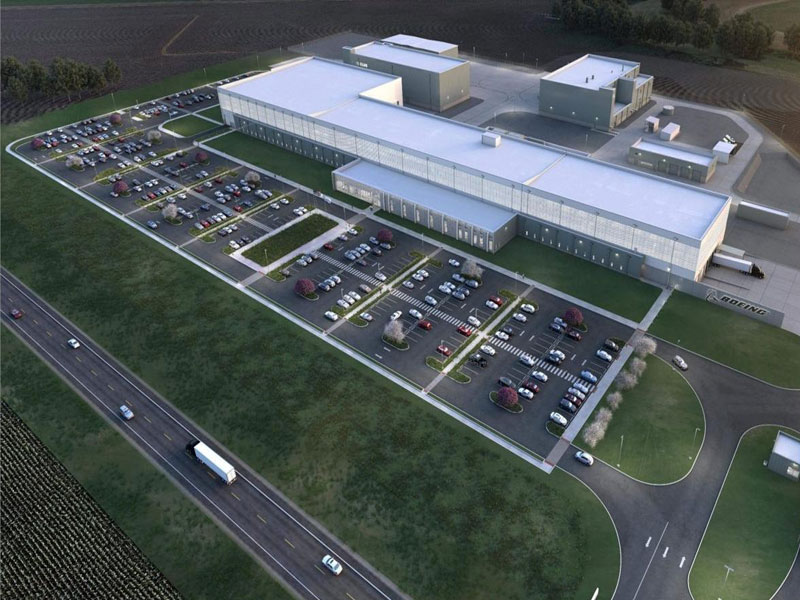Boeing puts drone assembly line in Metro East, could employ 300
SOURCE: MDJONLINE.COM
SEP 19, 2021

MASCOUTAH — Boeing’s newest assembly line is going in the Metro East.
The planemaker said Friday that it plans to build its MQ-25 Stingray refueling drone for the Navy in a 300,000-square-foot facility at MidAmerica Airport here starting in 2024.
Boeing will employ 150 mechanics, engineers and support staff initially, some of those newly hired, and could hire 150 more if the Navy keeps ordering the drones.
“This new state-of-the-art factory at the south end of the airport property represents a nearly $200 million investment by the Boeing Company in the future of safe, high-quality and efficient manufacturing,” said David Bujold, Boeing’s MQ-25 program director.
The unmanned drone marked yet another milestone in a remarkable turnaround for Boeing’s defense arm, which employs more than 15,000 in the region. Not long ago, officials worried they might have to trim thousands of jobs after Boeing lost contracts for a next-generation fighter jet and a long-range bomber. But now, with the military’s renewed interest in St. Louis-made Super Hornet and F-15 jets, plus recent wins on test planes and the MQ-25, the company is looking for more workers instead.
The announcement also marked a victory for proponents of MidAmerica Airport, long criticized as a financial boondoggle. Multiple dignitaries at a Friday news conference, including U.S. Sen. Dick Durbin, D-Ill., made a point of noting the new drone assembly will join existing Boeing operations producing components for the Chinook helicopter and the Super Hornet at the airport. As Durbin spoke, F-15s, which use the airport for test flights, roared overhead.
“This is a monumental day for this airport,” said Mark Kern, the St. Clair County Board Chairman. “I love it when a plan comes together.”
Illinois Gov. J.B. Pritzker noted the addition will also coincide with $57 million in state investment coming to help nearly double the size of the airport’s terminal and upgrade the runway.
“Paired with additional federal investment and private dollars, these investments will modernize our infrastructure, allowing new levels for public use,” Pritzker said.
Boeing is in line for state tax breaks worth roughly $8.7 million if the project works out as planned.
The company began working on the MQ-25 at least five years ago. At first, the Navy called for a pilotless fighter jet capable of executing long-range attacks, and then a few years ago, it shifted its focus to a refueling drone.
Such a plane is useful for a few reasons. First, potential adversaries such as China are developing anti-ship missiles that could force American aircraft carriers to set up farther from combat zones.
“It’s taking the carrier’s influence area and doubling it,” Bujold said.
Second, Super Hornets currently refuel planes in midflight. The drones would rest the Hornets, extend their lifespan and free up their pilots’ time for other tasks.
Boeing first won an $805 million contract to develop and produce four test Stingrays for the Navy in 2018, and last year the Navy exercised options to buy three more for $84.7 million.
Boeing has said it will deliver the first of those planes in the fall or winter of next year.
And if all goes well, more money — and jobs — could be on the way.
The Navy’s current plans call for as many as 72 Stingrays for an estimated $13 billion. Bujold, the program manager, said he expects a contract to be awarded in 2023.
LATEST NEWS
WHAT'S TRENDING


Data Science
5 Imaginative Data Science Projects That Can Make Your Portfolio Stand Out
OCT 05, 2022

Coventry University expert explains what Amazon drone deliveries means for jobs and the price of a package
SOURCE: HTTPS://WWW.COVENTRYTELEGRAPH.NET/
NOV 02, 2023
This New Autonomous Drone for Cops Can Track You in the Dark
SOURCE: HTTPS://WWW.WIRED.COM/
SEP 26, 2023
Tamil Nadu government approves farm mechanisation subsidy for Garuda Aerospace drones
SOURCE: HTTPS://AGRICULTUREPOST.COM/
SEP 25, 2023
The Future Of Biomedical Transport: Drones At The Service Of Health
SOURCE: HTTPS://WWW.EMERGENCY-LIVE.COM/
AUG 25, 2023
Groundbreaking Drone Flights with Radiation Detection Pave the Way for Improved Safety on Nuclear Sites
SOURCE: HTTPS://DRONELIFE.COM/
AUG 11, 2023
Drone with sticky patches studies biodiversity by bumping into trees
SOURCE: HTTPS://WWW.NEWSCIENTIST.COM/
JUL 13, 2023




